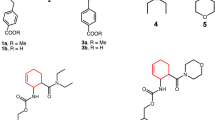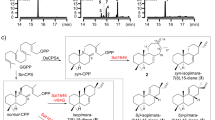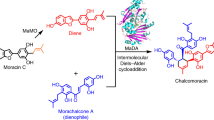Abstract
The natural product paracaseolide A is a tetracyclic dilactone containing six adjacent stereocentres. Its skeleton occupies a unique structural space among the >200,000 characterized secondary metabolites. Six different research groups have reported a chemical synthesis of this compound, five of which used a thermal, net Diels–Alder [4+2] cycloaddition and dehydration at 110 °C to access the target by dimerization of a simple butenolide precursor. Here, we report that this dimerization proceeds under much milder conditions and with a different stereochemical outcome than previously recognized. This can be rationalized by invoking a bis-pericyclic transition state. Furthermore, we find that spontaneous epimerization, necessary to correct the configuration at one key stereocentre, is viable and that natural paracaseolide A is racemic. Together, these facts point to the absence of enzymatic catalysis (that is, Diels–Alderase activity) in the cycloaddition and strongly suggest that a non-enzyme-mediated dimerization is the actual event by which paracaseolide A is produced in nature.
This is a preview of subscription content, access via your institution
Access options
Subscribe to this journal
Receive 12 print issues and online access
$259.00 per year
only $21.58 per issue
Buy this article
- Purchase on Springer Link
- Instant access to full article PDF
Prices may be subject to local taxes which are calculated during checkout





Similar content being viewed by others
References
Chen, X-L., Liu, H-L., Li, J., Xin, G-R. & Guo, Y-W. Paracaseolide A, first α-alkylbutenolide dimer with an unusual tetraquinane oxa-cage bislactone skeleton from Chinese mangrove Sonneratia paracaseolaris. Org. Lett. 13, 5032–5035 (2011).
Lammer, C. et al. The cdc25B phosphatase is essential for the G2/M phase transition in human cells. J. Cell Sci. 111, 2445–2453 (1998).
Yin, J-P. et al. Design and synthesis of paracaseolide A analogues as selective inhibitors of protein tyrosine phosphatase 1B inhibitors. Org. Biomol. Chem. 12, 3441–3445 (2014).
Gravel, E. & Poupon, E. Biogenesis and biomimetic chemistry: can complex natural products be assembled spontaneously? Nat. Prod. Rep. 27, 32–56 (2010).
Stocking, E. M. & Williams, R. M. Chemistry and biology of biosynthetic Diels–Alder reactions. Angew. Chem. Int. Ed. 42, 3078–3115 (2003).
Hideaki Oikawa, H. & Tokiwano, T. Enzymatic catalysis of the Diels–Alder reaction in the biosynthesis of natural products. Nat. Prod. Rep. 21, 321–352 (2004).
Kim, A. H. J., Ruszczycky, M. W., Choi, S-H., Liu, Y-N. & Liu, H-W. Enzyme-catalyzed [4+2] cycloaddition is a key step in the biosynthesis of spinosyn. Nature 473, 109–112 (2011).
Hashimoto, T. et al. Biosynthesis of versipelostatin: identification of an enzyme-catalyzed [4+2]-cycloaddition required for macrocyclization of spirotetronate-containing polyketides. J. Am. Chem. Soc. 137, 572–575 (2015).
Brophy, G. C. et al. Novel lignans from a Cinnamomum sp. from Bougainville. Tetrahedron Lett. 10, 5159–5162 (1969).
Chapman, O. L., Engel, M. R., Springer, J. P. & Clardy, J. C. The total synthesis of carpanone. J. Am. Chem. Soc. 93, 6696–6698 (1971).
Bandaranayake, W. M., Banfield, J. E. & Black, D. S. t. C. Postulated electrocyclic reactions leading to endiandric acid and related natural products. J. Chem. Soc. Chem. Commun. 902–903 (1980).
Nicolaou, K. C., Petasis, N. A., Zipkin, R. E. & Uenishi, J. The endiandric acid cascade. Electrocyclizations in organic synthesis. 1. Stepwise, stereocontrolled total synthesis of endiandric acids A and B. J. Am. Chem. Soc. 104, 5555–5557 (1982).
Noutsias, D. & Vassilikogiannakis, G. First total synthesis of paracaseolide A. Org. Lett. 14, 3565–3567 (2012).
Vasamsetty, L., Khan, F. A. & Mehta, G. Total synthesis of a novel oxa-bowl natural product paracaseolide A via a ‘putative’ biomimetic pathway. Tetrahedron Lett. 54, 3522–3525 (2013).
Giera, D. S. & Stark, C. B. W. Total synthesis of (±)-paracaseolide A and initial attempts at a Lewis acid mediated dimerization of its putative biosynthetic precursor. RSC Adv. 3, 21280–21284 (2013).
Boukouvalas, J. & Jean, M-A. Streamlined biomimetic synthesis of paracaseolide A via aerobic oxidation of a 2-silyloxyfuran. Tetrahedron Lett. 55, 4248–4250 (2014).
Vasamsetty, L., Sahu, D., Ganguly, B., Khan, F. A. & Mehta, G. Total synthesis of novel bioactive natural product paracaseolide A and analogues: computational evaluation of a ‘proposed’ biomimetic Diels–Alder reaction. Tetrahedron 70, 8488–8497 (2014).
Adam, W. & Rodriguez, A. Intramolecular silyl migration in the singlet oxygenation of 2-methyl-5-trimethylsilylfuran. Tetrahedron Lett. 22, 3505–3508 (1981).
Guney, T. & Kraus, G. A. Total synthesis of paracaseolide A. Org. Lett. 15, 613–615 (2013).
Caramella, P., Quadrelli, P. & Toma, L. Unexpected bispericyclic transition structure leading to 4+2 and 2+4 cycloadducts in the endo dimerization of cyclopentadiene. J. Am. Chem. Soc. 124, 1130–1131 (2002).
Ess, D. H. et al. Bifurcations on potential energy surfaces of organic reactions. Angew. Chem. Int. Ed. 47, 7592–7601 (2008).
Toma, L., Romano, S., Quadrelli, P. & Caramella, P. Merging of 4+2 and 2+4 cycloaddition paths in the regiospecific dimerization of methacrolein. A case of concerted crypto-diradical cycloaddition. Tetrahedron Lett. 42, 5077–5080 (2001).
Gagnepain, J., Castet, F. & Quideau, S. Total synthesis of (+)-aquaticol by biomimetic phenol dearomatization: double diastereofacial differentiation in the Diels–Alder dimerization of orthoquinols with a C2-symmetric transition state. Angew. Chem. Int. Ed. 46, 1533–1535 (2007).
Miles, W. H. et al. Amine-catalyzed epimerization of γ-hydroxybutenolides. Tetrahedron Lett. 48, 7809–7812 (2007).
CYLview, 1.0b (Université de Sherbrooke, 2009); http://www.cylview.org
Acknowledgements
T.W. acknowledges the support of a Wayland E. Noland Fellowship and a University of Minnesota Graduate School Doctoral Dissertation Fellowship. The computational aspects of this work were performed with hardware and software resources available through the University of Minnesota Supercomputing Institute (MSI). Some graphical images were created using CYLview25. We appreciate receiving guidance from a reviewer who encouraged us to explore in greater computational depth the Diels–Alder dimerization, which led to the identification of the fully symmetrical, bis-pericyclic transition-state structure. Financial support for the research was provided by the National Cancer Institute of the National Institutes of Health (NIH; CA76497). NMR spectra were recorded on an instrument purchased with support from the NIH Shared Instrumentation Grant programme (S10OD011952).
Author information
Authors and Affiliations
Contributions
T.W. and T.R.H. conceived and designed the experiments, analysed the data and co-wrote the paper. T.W. performed the experiments.
Corresponding author
Ethics declarations
Competing interests
The authors declare no competing financial interests.
Supplementary information
Supplementary information
Supplementary information (PDF 6595 kb)
Supplementary information
Crystallographic data for compound 1b. (CIF 21 kb)
Supplementary information
Crystallographic data for compound 7b. (CIF 15 kb)
Rights and permissions
About this article
Cite this article
Wang, T., Hoye, T. Diels–Alderase-free, bis-pericyclic, [4+2] dimerization in the biosynthesis of (±)-paracaseolide A. Nature Chem 7, 641–645 (2015). https://doi.org/10.1038/nchem.2281
Received:
Accepted:
Published:
Issue Date:
DOI: https://doi.org/10.1038/nchem.2281
This article is cited by
-
Demystifying racemic natural products in the homochiral world
Nature Reviews Chemistry (2022)
-
Sustainable Solvent-Free Diels–Alder Approaches in the Development of Constructive Heterocycles and Functionalized Materials: A Review
Topics in Current Chemistry (2022)
-
Non-enzymatic pyridine ring formation in the biosynthesis of the rubrolone tropolone alkaloids
Nature Communications (2016)



